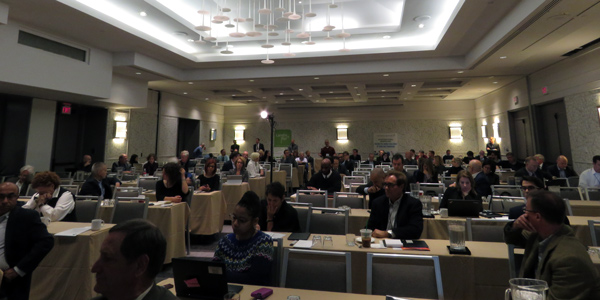WASHINGTON — Almost 190 investors, utility officials, technology company executives and others gathered for the GridWise Alliance’s two-day GridCONNEXT conference last week. Here’s some of what we heard.
FERC Enforcement, Tx Investment, Cybersecurity
Former FERC Commissioner Philip Moeller, a Republican, and Spencer Gray, a Democratic aide on the Senate Energy and Natural Resources Committee, talked about the newly reconstituted commission, transmission investment and the limited prospects for bipartisan action in Congress.

Moeller (left) and Gray | © RTO Insider
“We are at a low ebb in bipartisan relations,” Gray said.
But he said there was one exception. “I think there’s broad bipartisan consensus in the Senate to … focus more funds on cyber[security],” Gray said. “We’ve gotten [feedback] from a lot of groups in recent years that the federal government should have a more robust R&D program to develop new cyber tools and understanding of emerging cyber threats. That just seems like the lowest hanging fruit to me. It’s not a partisan issue at all.”
Moeller, who oversees the Edison Electric Institute’s business operations group and regulatory affairs, said the industry is “actually doing a very good job” on cybersecurity through the Electricity Subsector Coordinating Council. “But I’m not sure as an industry we necessarily tell our story well, partly because of the sensitivity” of the subject matter.
Moeller lamented the court rulings that rejected FERC’s “backstop” transmission siting authority in the 2005 Energy Policy Act. But he acknowledged the commission’s efforts to encourage transmission investment haven’t always been helpful.
“Our feeling is that the capital is out there but perhaps some of the [investment] signals need to be clarified. Whether it’s the [return on equity] mess at FERC, which I helped create unintentionally. But in trying to solve a problem, we’ve probably made it a little bit worse. I think there’s some uncertainty on the future of Order 1000. And it took a while I think for people to, like it or not, have the Clean Power Plan more in the rear-view mirror before they could focus on the expansion of the transmission grid.”
On Wednesday, EEI released a report suggesting changes to FERC’s ROE calculations that ClearView Energy Partners said could increase the model’s results by approximately 50 basis points.

GridConnext Audience | © RTO Insider
Gray said Sen. Maria Cantwell (D-Wash.), ranking member of the ENR Committee, will be watching “what happens under the new leadership of FERC to the Enforcement office.” In response to the abuses that contributed to the 2000-2001 Western Energy Crisis, Cantwell helped draft language in the 2005 Energy Policy Act that gave the commission increased authority over market manipulation.
Utility Execs Share Hurricane Lessons

Scott Prochazka, CEO of CenterPoint Energy and chairman of the GridWise Alliance, said Hurricane Harvey — “our third 500-year storm in two and a half years” — proved the “incredible” value of mobile substations. The company also is likely to add airboats and trucks able to drive through high water, he said. (See Weeks Later, Utility Officials Still Awed by Scale of Hurricane Harvey.)

Schimmenti | © RTO Insider
Robert Schimmenti, senior vice president of electric operations for Consolidated Edison, recalled how the utility was “humbled” by the 14-foot storm surge that drenched parts of Brooklyn and Lower Manhattan during Superstorm Sandy in 2012.
“All the weather predictions were around 12 feet. We did all the math and all the projections, and we thought we were good for about a 12-and-a-half-foot storm surge. It was only until a bunch of bright engineers linked the buoy data in the East River to a map of storm projections that they created — and this is well before high tide — and as they created these projections, we were like ‘Hey, wait a second. This doesn’t look good.’”
More than 1 million Con Ed customers in New York City and Westchester County lost power during the storm. The company has spent $847 million to make its system more resilient, including the addition of “smart switches” to isolate and clear trouble on lines, flood gates, pumps and 3 miles of flood walls around critical equipment.
Recovery in the Caribbean

Hurricane Maria took down “only” 220 230-kV towers in Puerto Rico, said Bruce Walker, assistant secretary for the Department of Energy’s Office of Electricity Delivery and Energy Reliability. But replacing each tower is a five- to seven-day project requiring ferrying of workers and equipment by helicopter, Walker said.
“One of the things that was striking to me regarding their system is their transmission lines; while very well built, [they’re] built right through the mountains. There are no rights of way; there are no roads. There is no tree clearing in those areas.”
Praveen Kathpal, vice president of AES Energy Storage, said his company recently outlined for the Puerto Rico Energy Commission “a vision of how 10 GW of solar plus 2.5 GW of storage, arranged in essentially sectionalized grids across the island, could provide both resilience and lower costs, because those [investments] break even with how much Puerto Rico would spend on burning oil for power generation over the next 10 years.”
Kathpal said AES’ 10-MW battery installations in the Dominican Republic “rode through all the grid disturbances of Hurricanes Irma and Maria” despite damage to transmission lines and generation outages. “A battery installation is physically resilient. It’s not as subject to the factors that during an intense storm would cause other resources to disconnect. So even as 40 to 60% of the generation in the Dominican Republic tripped off, the batteries continued to operate. And as you can imagine with those kinds of generation trips, the frequency was flopping all over the place. So they actually did more work to restabilize the system.”
— Rich Heidorn Jr.




